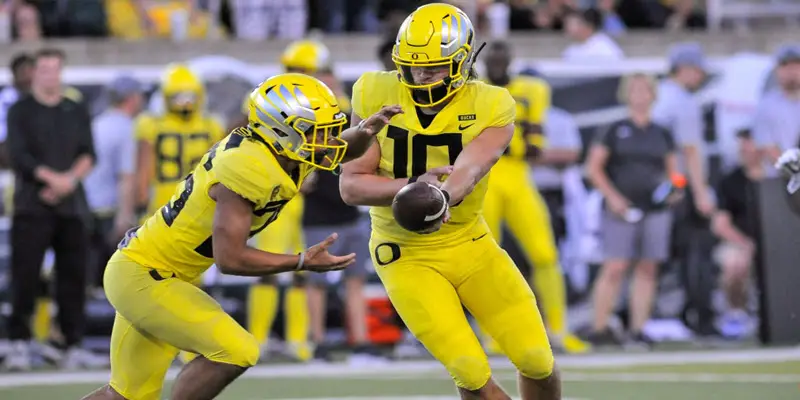If you want a fluffy editorial, this ain’t it. I am not going to cover the same stuff as other media — that everyone can already see, such as dropped passes, elite throws by Justin Herbert, improvements on the defense, etc. I will focus on what I am passionate about on offense, and I was dismayed at what I saw against Bowling Green by the Mario Cristobal staff. It is evident to me that the trend that began last year, of using the successful backside Zone Read much less, is now even further on the decline and on its way out of the Oregon offense.
“This offensive tactic put Oregon in the top five in offense and scoring for years — and we are turning away from it? What the Ducks replace it with had better be good …”
There is so much of what I saw that was both good and disappointing, that I simply cannot write a 4,000 word white paper on it. It is a good thing we have a whole season to break this down and learn more football in the process. I will focus on a fundamental of the Oregon offense since 2007, the Zone Read, and give my opinions about where we are going, and I welcome more knowledgeable readers to offer their input in the comments.
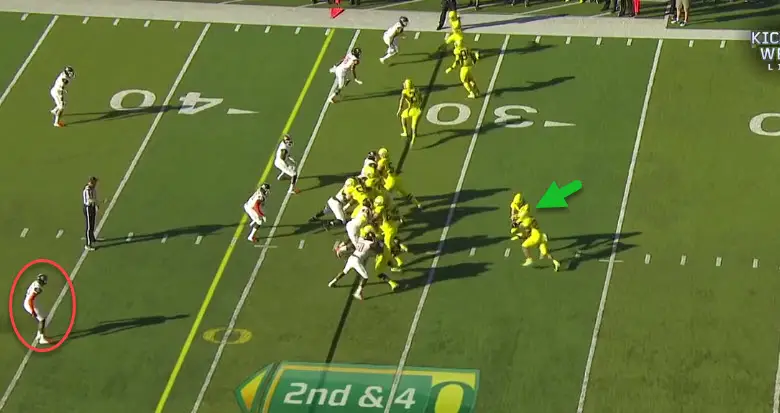
The backside OLB/Safety prevents the QB from pulling the ball and has perimeter defense.
Above we see the beginning of an Inside Zone Read in the game against Bowling Green, and QB Justin Herbert (green arrow above) is reading the OLB/Safety on the backside of the play. The play is meant to go wherever the running back sees a hole, and if there is no outside contain defender, then the QB will pull the ball and run down the backside of the defense in the open field. Since there is a “contain” defender on this play (circled in red above), then Herbert will hand off to the running back.
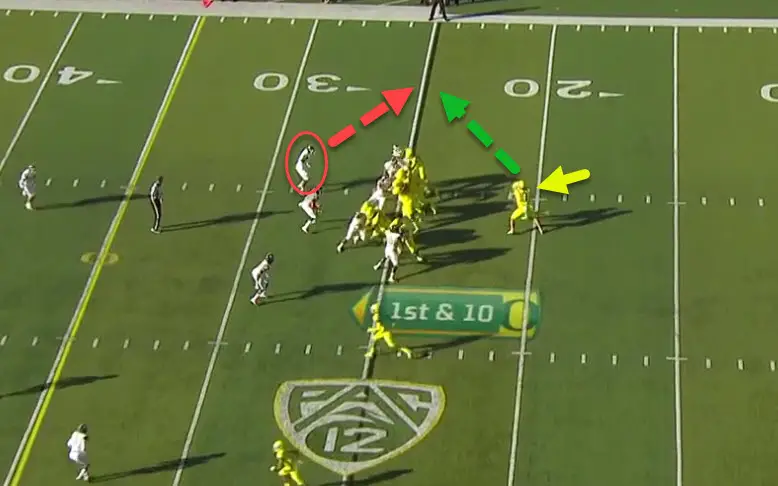
At this location, the OLB/Safety can still prevent the QB Keeper.
The outside linebacker (OLB) placement above in this different play at the moment of the Zone Read is just enough behind the line of scrimmage (LOS) to convince Herbert that, if the ball is pulled, the OLB will meet the Oregon quarterback at the LOS for minor gains.

This OLB/Safety has cheated to the inside at play inception.
Look at how the contain defender (circled in red above) has placed himself much more inside at the beginning of another play. You can bet that Herbert notices …
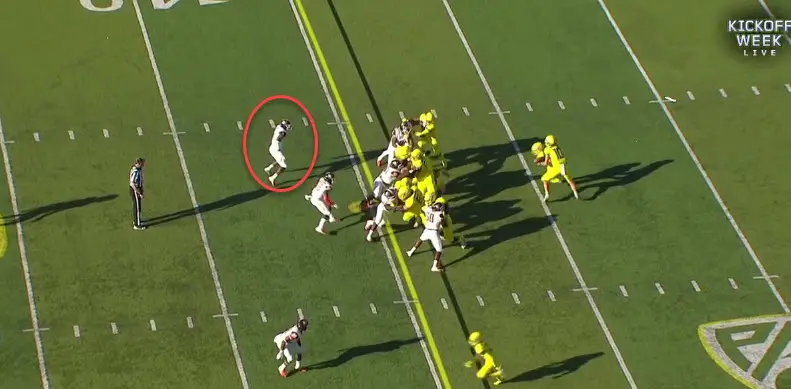
Herbert makes the right read and knows he can beat the defender to the corner.
At this moment of the Zone Read (above), we can see this perimeter defender is a full yard or two inside Oregon’s tight end and leaning inside. Herbert knows he can pull the ball and beat the defender to the corner.
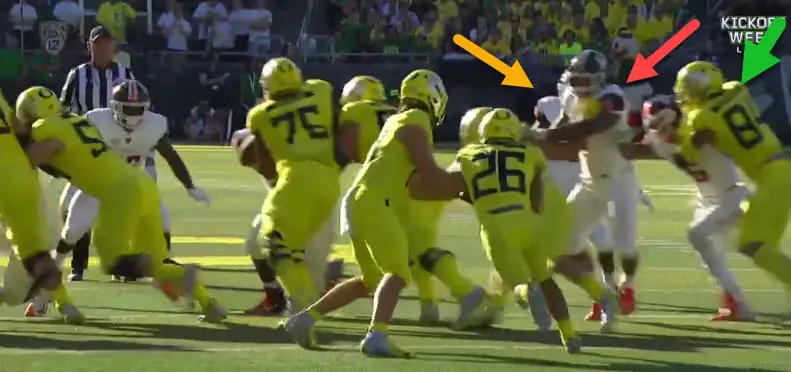
Defensive players are stacked inside to stop the Inside Zone component of the play.
Above you can see the linebacker and safety charging forward (red and orange arrows above) to stop the Inside Zone play and running back, Travis Dye. Note also the terrific block by Cam McCormick (No. 84 and green arrow above), who caves in the right side and makes Herbert’s scoot that much easier.
In my view, this (above) is the ideal way to run your quarterback — on the backside of a defense, where he can run out of bounds or slide in open field easily. The intent is simply to keep the defense honest and to free up an extra blocker as Oregon doesn’t have to block the defender being “read,” which gives more power to the running game. This play is what brought Oregon from not leading the conference in rushing in over 30 years to leading the conference in rushing for a decade with undersized, but talented and fast, offensive linemen.
Say what you want about it, but it works.
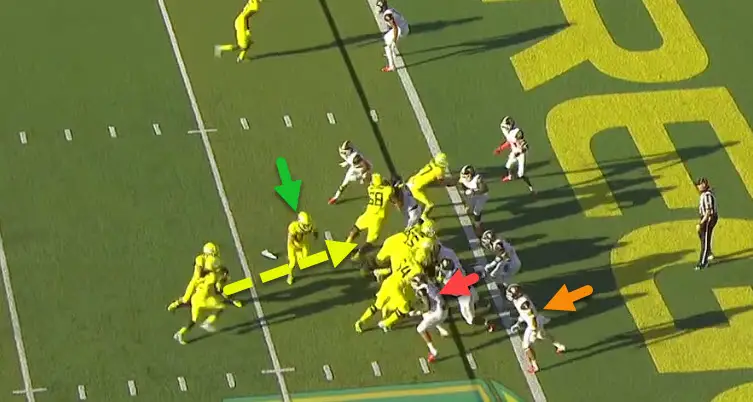
The read was to hand off …
This play at the goal line was another Inside Zone Read, with the running back (yellow dotted line/arrow above) usually receiving the ball. That is especially true when you have the defender on the LOS “sitting” (red arrow above). The read is to hand the ball off to the RB, especially when you have a second perimeter defender (orange arrow above) out there as well.
Note that the green arrow above is an H-Back coming across and doing a slice block Coach Boles wrote about recently, but this is not meant to operate like an Inverted Veer play. This was a decision by Herbert to run it inside regardless of the read, despite the risk to him. Can you recall Cal of 2017?
Oregon has run an Inverted Veer in the past, where you make the Zone Read on the side the play is intended to run, or the playside. But we are seeing quarterbacks pulling the ball and running into the teeth of the defense … between the tackles and not on the backside as seen in the earlier example.
My friends, above you see Braxton Burmeister running between the tackles, as you saw Herbert do, so I can only conclude that they are being coached to do so. I cannot imagine that any gain made on this play is equal to the risk to our quarterbacks. Perhaps this is how the Pistol works? If so, I disagree. It is stupid-as-hell.
What I saw in that game was a noticeable absence of backside Zone Reads and a flawed decision-making process by the quarterbacks. Most of the plays you watched were a version of the NFL/Alabama Stretch play, where instead of picking up an extra blocker on the playside, as Oregon did with a backside Zone Read, the reliance is on straight-ahead power blocking. Is that really going to work against Stanford, Washington and Auburn next year?
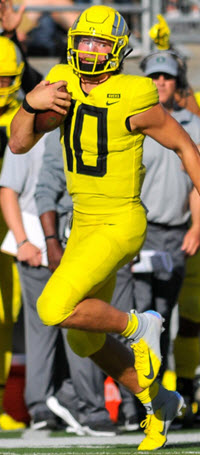
Let’s keep Justin Herbert in the open field…
The pin-and-pull sweep plays also were straight hand-offs, (like you see in the top picture–no Zone Read, just a handoff), with no backside Zone Read. So again, no extra blocker on the point of attack. We saw no Outside Zone Reads or Sweep Reads, as we did last year, and the passing game will be reserved for future analysis. The bottom line is that the fears I wrote about last week are coming true.
Yes, I know it is early in the season, and Coach Cristobal could be rolling out a lot more as the season progresses, but I am acting as the canary (Duck) in the coal mine for many fans. These developments are worthy of keeping an eye on, and while I am delighted with 58 points overall, I am concerned about the ability to sustain it over the course of a season with the trends we are seeing.
If Coach Cristobal can keep up the scoring at Oregon we are accustomed to — super. He stated years ago that he wanted to see the Oregon offense with toughness in the trenches … but this is not the Oregon offense he watched on television.
And so many people think I’m just an Oregon homer!
I call it the way I see it because … “oh how I love to ponder about our Beloved Ducks!”
Charles Fischer (FishDuck)
Eugene, Oregon
Top Photo by Kevin Cline
Related Articles:

Charles Fischer has been an intense fan of the Ducks, a season ticket holder at Autzen Stadium for 38 years and has written reports on football boards for over 26 years. Known as “FishDuck” on those boards, he is acknowledged for providing intense detail in his scrimmage reports, and in his Xs and Os play analyses. He is single, has a daughter Christine, and resides in Eugene Oregon where he was a Financial Advisor for 36 years.
He now focuses full-time on Charitable Planned Giving Workshops for churches and non-profit organizations in addition to managing his two Oregon Football Websites, of FishDuck.com and the Our Beloved Ducks forum. He is a busy man!
He does not profess to be a coach or analyst, but simply a “hack” that enjoys sharing what he has learned and invites others to correct or add to this body of Oregon Football! See More…

